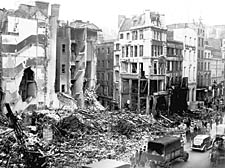|
|
 |
| |

Image of the Blitz bombing campaign during the Second World War that killed thousands across the capital
Photo: The Museum of London |
Bones from the Blitz dead are found in park
Children discover fragments of bodies thought to have been buried during war
HUMAN bones believed to be the remains of victims of the Blitz have been discovered in Regent’s Park by children digging in the soil.
Parks bosses are now considering whether to order a mass dig to see if there could be further finds.
Detectives from Camden CID were initially called in to investigate but the case has been officially classified as an “archaeological find” and will not be subject to a full police inquiry.
The bones were found by a group of unwitting youngsters playing on the Camden side of the park, near the playground by Gloucester Gate.
The discovery was made in May but the find was not publicised and is regarded as a sensitive case by the Royal Parks Agency, which manages the grounds. It will not reveal the exact site where the bones were found amid fears it could lead to a rush of amateur bone collectors and archaeologists visiting the scene.
Historians have always known the park was used as an emergency burial ground by the British government during wartime but few expected remains to surface.
Reports seen by the New Journal show a forensic anthropologist from the Natural History Museum has been called in. Initial findings suggest the bones were almost certainly buried in the rubble of nearby houses destroyed by the Luftwaffe raids in 1940 and 1941. The museum is making provision for the bones to be released for a proper burial.
The possibility of a dig for further remains has provoked a strong reaction from some older residents, with calls for Parks bosses to “respect the dead” and leave the land undisturbed.
More than 30,000 people died, and around a third of the city was destroyed by the German bombing campaign on the capital, including extensive damage to Camden, with Harrington Square, Albany Street and St Mark’s Square all hit.
Police have written to St Pancras coroner Dr Andrew Reid but he has indicated that the remains are too old to conduct an inquest.
A report from the forensic anthropologist at the Natural History Museum said: “Some schoolchildren found some bone fragments on the soil surface while playing in Regent’s Park. The police were immediately contacted and the area was secured. The Natural History Museum was then asked by the police to determine the nature of bone fragments. We determined that the bones were a mixture of human and animal remains. They were discovered in context with household rubble which was deposited in the park after the Blitz. The actual age of the remains has not been determined – we can only be certain that they were deposited with the rubble so the individuals died prior to 1941.”
Peter Russell, chairman of Westminster North Community Police Consultative Group, who was 10 years old during the Blitz, and lived beside the park, said: “It is possible there could be loads of bones down there and you could just dig it up, but I think people of my generation would be pretty wary of it. It’s to do with respecting the dead and literally raking up old graves.” But Malcolm Kafetz, chairman of the Friends of Regent’s Park, said: “I would support a dig. I think we need to know what’s down there.”
A police spokeswoman said: “The bones have been examined by an anthropologist, who is satisfied that they are human bones, and cow or sheep bones, possibly from domestic waste and are of an age consistent with World War Two. It is highly likely to be as a result of the practice of spreading the remains of bones bombed during the Blitz in the park and then covering them with top soil.” |
 |
|
|
 |
| |
| |
|
 |
|